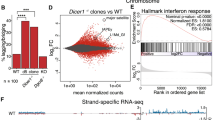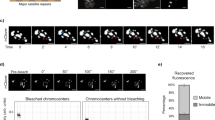Abstract
RNA interference is an evolutionarily conserved gene-silencing pathway in which the nuclease Dicer cleaves double-stranded RNA into small interfering RNAs1. The biological function of the RNAi-related pathway in vertebrate cells is not fully understood. Here, we report the generation of a conditional loss-of-function Dicer mutant in a chicken–human hybrid DT40 cell line that contains human chromosome 21. We show that loss of Dicer results in cell death with the accumulation of abnormal mitotic cells that show premature sister chromatid separation. Aberrant accumulation of transcripts from α-satellite sequences, which consist of human centromeric repeat DNAs, was detected in Dicer-deficient cells. Immunocytochemical analysis revealed abnormalities in the localization of two heterochromatin proteins, Rad21 cohesin protein and BubR1 checkpoint protein, but the localization of core kinetochore proteins such as centromere protein (CENP)-A and -C was normal. We conclude that Dicer-related RNA interference machinery is involved in the formation of the heterochromatin structure in higher vertebrate cells.
This is a preview of subscription content, access via your institution
Access options
Subscribe to this journal
Receive 12 print issues and online access
$209.00 per year
only $17.42 per issue
Buy this article
- Purchase on Springer Link
- Instant access to full article PDF
Prices may be subject to local taxes which are calculated during checkout





Similar content being viewed by others
References
Hannon, G.J. RNA interference. Nature 418, 244–251 (2002).
Provost, P. et al. Dicer is required for chromosome segregation and gene silencing in fission yeast cells. Proc. Natl Acad. Sci. USA 99, 16648–16653 (2002).
Hall, I.M., Noma, K. & Grewal, S.I.S. RNA interference machinery regulates chromosome dynamics during mitosis and meiosis in fission yeast. Proc. Natl Acad. Sci. USA 100, 193–198 (2003).
Volpe, T. et al. RNA interference is required for normal centromere function in fission yeast. Chromosome Res. 11, 137–146 (2003).
Choo, K.H.A. The Centromere. (Oxford University Press, Oxford, UK, 1997).
Hudson, D.F., Morrison, C., Ruchaud, S. & Earnshaw, W.C. Reverse genetics of essential genes in tissue-culture cells: 'dead cells talking'. Trends Cell Biol. 12, 281–287 (2002).
Bernstein, E. et al. Dicer is essential for mouse development. Nature Genet. 35, 215–217 (2003).
Lander, E.S. et al. Initial sequencing and analysis of the human genome. Nature 409, 860–921 (2001).
Ikeno, M., Masumoto, H. & Okazaki, T. Distribution of CENP-B boxes reflected in CREST centromere antigenic sites on long-range a-satellite DNA arrays of human chromosome 21. Hum. Mol. Genet. 3, 1245–1257 (1994).
Ikeno, M. et al. Construction of YAC-based mammalian artificial chromosomes. Nature Biotech. 16, 431–439 (1998).
Brown, W.R., Hubbard, S.J., Tickle, C. & Wilson, S.A. The chicken as a model for large-scale analysis of vertebrate gene function. Nature Rev. Genet. 4, 87–98 (2003).
Sonoda, E. et al. Scc1/Rad21/Mcd1 is required for sister chromatid cohesion and kinetochore function in vertebrate cells. Dev. Cell 1, 759–770 (2001).
Partridge, J.F., Borgstrom, B. & Allshire, R.C. Distinct protein interaction domains and protein spreading in a complex centromere. Genes Dev. 14, 783–791 (2000).
Scueler, M.G., Higgins, A.W., Rudd, M.K., Gustashaw, K. & Willard, H.F. Genomic and genetic definition of a functional human centromere. Science 294, 109–115 (2001).
Sullivan, B.A. Centromere round-up at heterochromatin corral. Trends Biotech. 20, 89–92 (2002).
Volpe, T.A. et al. Regulation of heterochromatic silencing and histone H3 lysine-9 methylation by RNAi. Science 297, 1833–1837 (2002).
Schramke, V. & Allshire, R. Hairpin RNAs and retrotransposon LTRs effect RNAi and chromosome-based gene silencing. Science 301, 1069–1074 (2003).
Spence, J.M. et al. Co-localization of centromere activity, proteins and topoisomerase II within a subdomain of the major human X α-satellite array. EMBO J. 21, 5269–5280 (2002).
Bernard, P., Maure, J.-F., Partridge, J.F., Genier, S., Javerzat, J.-P. & Allshire, R.C. Requirement of heterochromatin for cohesion at centromeres. Science 294, 2539–2542 (2001).
Nonaka, N. et al. Recruitment of cohesin to heterochromatic regions by Swi6/HP1 in fission yeast. Nature Cell Biol. 4, 89–93 (2002).
Hayakawa, T., Haraguchi, T., Masumoto, H. & Hiraoka, Y. Cell cycle behavior of human HP1 subtypes: distinct molecular domains of HP1 are required for their centromeric localization during interphase and metaphase. J. Cell Sci. 116, 3327–3338 (2003).
Nakayama, J., Rice, J.C., Strahl, B.D., Allis, C.D. & Grewal, S.I. Role of histone H3 lysine 9 methylation in epigenetic control of heterochromatin assembly. Science 292, 110–113 (2001).
Bannister, A.J. et al. Selective recognition of methylated lysine 9 on histone H3 by the HP1 chromo domain. Nature 410, 120–124 (2001).
Blower, M.D., Sullivan, B.A. & Karpen, G.H. Conserved organization of centromeric chromatin in flies and humans. Dev. Cell 2, 319–330 (2002).
Pal-Bhadra, M. et al. Heterochromatic silencing and HP1 localization in Drosophila are dependent on the RNAi Machinery. Science 303, 669–672 (2004).
Fukagawa, T. et al. CENP-H, a constitutive centromere component, is required for centromere targeting of CENP-C in vertebrate cells. EMBO J. 20, 4603–4617 (2001).
Fukagawa, T. & Brown, W.R.A. Efficient conditional mutation of the vertebrate CENP-C gene. Hum. Mol. Genet. 6, 2301–2308 (1997).
Nishihashi et al. CENP-I is essential for centromere function in vertebrate cells. Dev. Cell 2, 463–476 (2002).
Fukagawa, T., Pendon, C., Morris, J. & Brown, W. CENP-C is necessary but not sufficient to induce formation of a functional centromere. EMBO J. 18, 4196–4209 (1999).
Acknowledgements
The authors are very grateful to K. Kita and Y. Fukagawa for technical assistance. This work was supported by the PRESTO of JST and by a Grant-in-Aid for Scientific Research on Priority Areas — Genome Biology, Cancer Cell Biology and Cell Cycle — from the Ministry of Education, Science, Sports and Culture of Japan. The work in the laboratory of M.O. was supported partly by a Human Genome and Tissue Engineering programme grant from the Minister and Labour Science Research Grants.
Author information
Authors and Affiliations
Corresponding author
Ethics declarations
Competing interests
The authors declare no competing financial interests.
Supplementary information
Supplementary Figures
Fig. S1, Fig. S2, Fig. S3 and Fig. S4 (PDF 572 kb)
Rights and permissions
About this article
Cite this article
Fukagawa, T., Nogami, M., Yoshikawa, M. et al. Dicer is essential for formation of the heterochromatin structure in vertebrate cells. Nat Cell Biol 6, 784–791 (2004). https://doi.org/10.1038/ncb1155
Received:
Accepted:
Published:
Issue Date:
DOI: https://doi.org/10.1038/ncb1155
This article is cited by
-
Dicer promotes genome stability via the bromodomain transcriptional co-activator BRD4
Nature Communications (2022)
-
Epigenetic rewriting at centromeric DNA repeats leads to increased chromatin accessibility and chromosomal instability
Epigenetics & Chromatin (2021)
-
Conserved chromosomal functions of RNA interference
Nature Reviews Genetics (2020)
-
Genetic and epigenetic effects on centromere establishment
Chromosoma (2020)
-
Epigenetic regulation of centromere function
Cellular and Molecular Life Sciences (2020)



